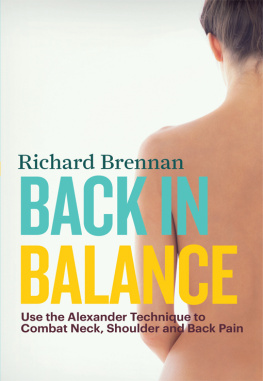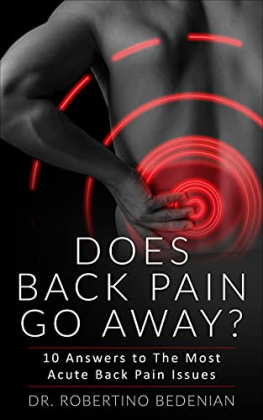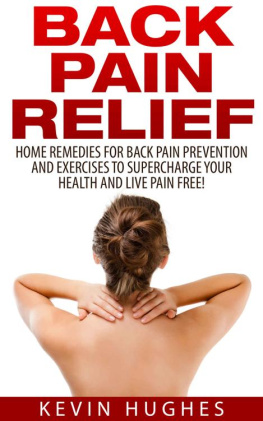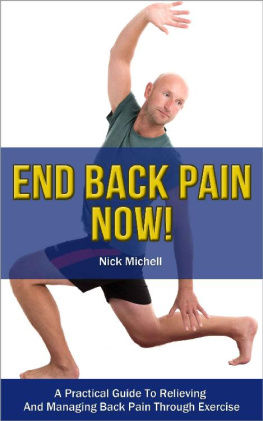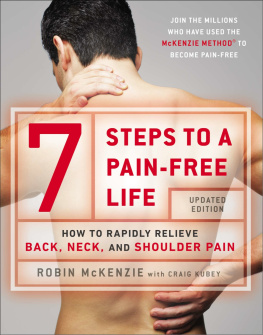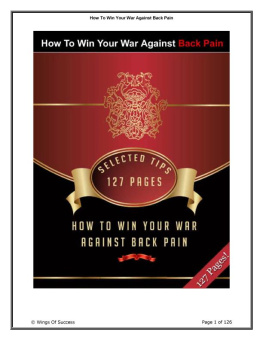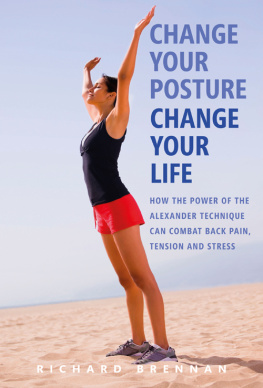BACK IN BALANCE
Use the Alexander Technique to
Combat Neck, Shoulder and Back Pain
Richard Brennan

F OREWORD
A LEXANDER T ECHNIQUE AND B ACK P AIN :
A D OCTOR S E XPERIENCE
Six months before I qualified as a doctor in 1990, while on a medical elective attachment in Sri Lanka, I suffered an injury which changed my life. During my first attempts to learn how to surf I was swept up by an eight-foot wave and dumped, face-first in a diving posture, onto the sea-bed. The facial impact and neck pain were immediately quite severe, but it was only later as I kept spilling drinks into my lap and with persistent numbness in my arm that I realized I had sustained a nerve root injury in my neck. A neurosurgical consultation and X-rays reassured me that I hadnt actually broken my neck and I was able to continue the attachment, but my surfing days were well and truly over.
Over the next twelve years I was beset with constant, increasing, neck, bilateral arm and upper back pain. Following a minor incident the night before my MRCGP exam in 1994, I suffered third-level nerve root pain and weakness in my arm. The subsequent MRI scan showed markedly accelerated degeneration of the vertebrae and discs in my cervical spine, with the expected nerve root compression from bulging discs and osteophytes. The discal bars were also indenting my spinal cord. The neuroradiographer commented, You have the spine of a seventy year old. I was thirty-two!
Although I managed to carry on working as a GP, I continued to suffer unrelenting mechanical and nerve root pain. Around 2000, I consulted four consultant neurosurgeons, who all recommended different operations, ranging from simple removal of a single intervertebral disc, to removal of two or three discs with plating and filler, to replacement of a disc with a prototype Cummins articulating intervertebral joint replacement. My concern about having any such surgery was the increased stresses that would inevitably act on adjacent vertebrae in my neck. I knew that something was still causing large compressive forces to act on my spine even after a decade following the initial injury. Rather than recovering, I was deteriorating. Having found a great neurosurgeon who shared my understanding of the mechanics involved, I was listed for the Cummins joint-replacement operation. It was retrospectively fortunate that, three days before the operation, the pre-op MRI showed that the disc space had completely collapsed, significantly reducing the chances of a successful outcome. After some discussion, we agreed that the best option at that time was to cancel the operation.
I struggled on until, in 2002, there came a point when I became unable to lift my stethoscope to listen to someones chest. The pain had somehow changed in nature and had become of an unbearable intensity; my right hand had swelled and changed colour, and there were changes to the skin, nail and hair growth when compared with my left hand. I had developed complex regional pain syndrome (formerly and I think more accurately known as reflex sympathetic dystrophy). This syndrome is not properly understood in medicine: many doctors still wrongly believe it to be a factitious condition that denotes an excessive individual response to pain perception, mediated solely by the phenomenon of central (brain) sensitisation. I was unable to work for a year after I first developed CRPS. I could not turn my head or look up. I was unable to sit or lie back against any surface; sleeping was a nightmare. The pain from someone hugging me or shaking my hand was excruciating. Eventually, my weak and pain-riddled right arm started to lose its neurological tone and co-ordination and it began to flap limply as I walked.
Since 1990, I had seen a variety of osteopaths and chiropractors, receiving variable treatments, which had afforded differing degrees of transient relief. With increasing desperation, by 2002 I had also tried homeopathy, reflexology, acupuncture and even faith healing. It was ultimately a combination of two brave and iron-handed osteopaths who, by skilfully and forcefully freeing my jammed and displaced upper ribs, began the very slow healing process. In my case, it became apparent that the underlying pathology lay in the mechanical distortion of the sympathetic trunk (a large nerve bundle containing regulatory nerve cells and fibres) as it runs over the upper rib heads next to the spine.
A major impediment to my recovery was that, as a result of the long-standing neuromuscular changes in my spine, minimal movements would cause the ribs and vertebral joints to jam up again, invoking the return of the pain. The spinal neuromusculoskeletal network recalibrates muscle settings over time, such that the dysfunctional settings become registered as normal by the body. My central neuromuscular reflexes and programming had been usurped by years of reacting to, and compensating for, pain and dysfunction that had progressed to encompass my whole spine. I continued to see osteopaths when necessary to unjam my ribs, but I realized that my posture and the way that I was doing things were instrumental in causing the problems to recur.
I first saw an Alexander Technique teacher in early 2002, some time after my wife had attended baby massage sessions at our local GP surgery. My wife had been shown by the visiting Alexander teacher how she was hunching and stooping when pushing the buggy and in a few easy minutes was guided into an effortless and more comfortable way to propel the pushchair. The effect on my wife of that one brief intervention was lasting and notable enough for me to want to try the Alexander Technique, although at the time I was more hoping for therapy rather than for tuition. As I have since learned, however, the benefit of being correctly taught the Alexander principles is that they can continue to be employed indefinitely, with continuing benefit.
I found a local Alexander teacher, but I felt that she was not the right person for me and it was then that I contacted Brita Forsstrom, a well-respected member of the Society for Teachers of Alexander Technique in the UK. Within a few sessions, I could sense that beneficial changes were occurring in my body as a result of applying the principles I was learning. I noticed that I could achieve diminution of pain in posture and movement if only I could hold on to what was happening in the lessons. It took a little longer for me to properly understand and implement the key concepts of conscious inhibition and direction. Britas gifted hands were an essential component in the initial process of me feeling what was happening in my own body and then developing the awareness and control over how to change it.
One of the effects of neuromuscular recalibration is that we cannot then rely on our own kinaesthetic sense of what is normal posture. Simply put, we all need a mirror to know whether or not our feeling of standing up straight is in fact correct or not. More often than not, it isnt. The Alexander teachers eyes and hands are therefore essential to provide objectivity in the kinaesthetic reorganization process.
By superimposing Alexander principles over my sub-voluntary postural and pain responses, I gradually became able to undo subtle patterns of gross and postural movements that had been aggravating and helping to maintain the strain patterns in my spine. After an Alexander lesson I would be in much less pain; I felt lighter in my body and consequently my mood. I noticed improved balance, strength and co-ordination and calmness in my movements.

